Audi 100
The Audi 100, Audi 200, (and sometimes called Audi 5000 in North America), are primarily four-door, front-engine, front- or all-wheel drive full-size/executive cars, manufactured and marketed by the Audi division of the Volkswagen Group for model years 1968 through 1994 — across four generations (C1–C4), with a two-door model available in the first and second generation (C1-C2), and a five-door model available in the last three generations (C2–C4), evolving from a liftback design, similar to Volkswagens contemporaneous Passat on the C2, to a more conventional stationwagon on the C4.
| Audi 100 / Audi 200 / Audi 5000 | |
|---|---|
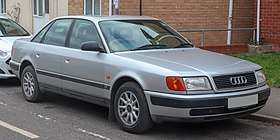 | |
| Overview | |
| Manufacturer | Auto Union GmbH, Audi NSU Auto Union AG (1969–1985), Audi AG |
| Also called | Audi 5000 |
| Production | 1968–1994 |
| Body and chassis | |
| Class | Mid-size luxury / Executive car (E) |
| Layout | front engine, front-wheel drive or quattro four-wheel-drive |
| Platform | Volkswagen Group C platform |
| Chronology | |
| Predecessor | Horch P240 [1] |
| Successor | Audi A6 |
In 1982, the third generation Audi 100/5000's aerodynamic design achieved a remarkably low drag coefficient of just 0.30 for its time, featuring completely flush greenhouse sides, including unique new sliding window mountings.
The C2 and C3 models of the Audi 100 were marketed in North America as the Audi 5000 from 1984 to 1988, and in South Africa as the Audi 500.
In 1994, the models were mildly restyled, and renamed the Audi A6 series in conjunction with a general new Audi naming scheme, until they were relieved by a new generation of A6, internally code-named C5, in 1997.
Audi 100 (C1, 1968–1976)
| Audi 100 C1 (F104) | |
|---|---|
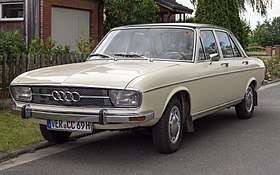 Audi 100 (C1) | |
| Overview | |
| Production | 1968-1976 827,474 built Saloon: 796,787 Coupé S: 30,687[2] |
| Assembly |
|
| Designer | Ludwig Kraus |
| Body and chassis | |
| Body style | 2-/4-door saloon/sedan 2-door coupé |
| Layout | FF layout |
| Platform | Volkswagen Group C1 platform |
| Powertrain | |
| Engine | |
| Transmission | 4-speed manual all-synchromesh[3] automatic optional[3] |
| Dimensions | |
| Wheelbase | 105.3 in (2,675 mm)[3] (coupé) |
| Length | 173.2 in (4,399 mm)[3] |
| Width | 68 in (1,727 mm)[3] |
| Height | 55.8 in (1,417 mm)[3] |
| Curb weight | 2,401 lb (1,089 kg)[3] (coupé) |
The first Audi 100, developed by Volkswagen's very much subsidiary Auto Union at Ingolstadt, was shown to the press as a four-door sedan on 26 November 1968. Its name originally denoting a power output of 100 PS (74 kW), the Audi 100 was the company's largest car since the revival of the Audi brand by Volkswagen in 1965. The C1 platform spawned several variants: the Audi 100 two- and four-door saloons, and the Audi 100 Coupé S, a fastback coupé, which bore a resemblance to the Aston Martin DBS released a year earlier, especially at the rear end, including details such as the louvres behind the rear side windows and the shape of the rear light clusters.
Audi followed up the introduction of the four-door saloon in November 1968 with a two-door saloon in October 1969 and the 100 Coupé S in autumn 1970. The cars' 1.8 litre four-cylinder engines originally came in base 100 (80 PS or 59 kW or 79 hp), 100 S (90 PS or 66 kW or 89 hp), and 100 LS (100 PS or 74 kW or 99 hp) versions, while the Coupé was driven by a bored-out 1.9 litre developing 115 PS (85 kW; 113 hp). From April 1970 the 100 LS could be ordered with a three-speed automatic transmission sourced from Volkswagen.
Although the Audi 100's engines were considered rather "rough", critics stated that buyers whose first car had been a Beetle and who aspired to upgrade to a contemporary diesel-powered Mercedes-Benz were unlikely to be discouraged.[4] The Ingolstadt production line was at full capacity, but supply fell short of demand that during the summer of 1970 an additional production line for Audi 100s was set up in Volkswagen's own Wolfsburg plant, which made it the first water-cooled car to be produced in Germany's (and by some criteria the world's) largest car plant.[5] For the Swiss market, the 100 LS was equipped with a version of the 1.8-liter engine bored out by 0.5 mm (0.020 in), producing 107 PS (79 kW).[6] This placed the engine above the 9 tax horsepower threshold in the 19 cantons where this system was in use; why this was desired is unknown.[7]
Starting with the 1972 model year, the 80 and 90 PS versions were replaced by a new regular-petrol-variant of the 1.8 litre engine developing 85 PS (84 hp/63 kW); at the same time, the 100 GL was introduced featuring the 1.9 liter engine formerly used only in the Coupé S.
In March 1971 the 500,000th Audi was produced. By now the Audi 100 had become the most commercially successful model in the company's history.[8] In 1976 the two millionth Audi was built, of which the 100 represented 800,000 cars.[9]
In September 1973 (for the 1974 model year) the 100 received a minor facelift with a somewhat smaller squared-off grille, with correspondingly more angular front fenders, and with reshuffled taillight lens patterns. The rear torsion bar was replaced by coil springs. For model year 1975 the base 100 was re-christened the 100 L and received a 1.6 litre four-cylinder engine (coming out of the Audi 80). A four-wheel drive prototype of the Audi 100 C1 was built in 1976, long before the appearance of the quattro.[10]
In South Africa, where the 100 was also assembled, the 100 was available as the L, LS, GL, and S Coupé. Local production began towards the end of 1972; by October 1976 33,000 units had been built in South Africa.[9] The GL received a vinyl roof and "GL" lettering on the C-pillar. The LS was dropped for 1976, but returned for 1977 along with the new GLS saloon. The Coupé was discontinued. The LS and GLS were special versions of the L and GL, with silver paintjobs, automatic transmissions, and special red interiors. L and LS have a 1760 cc engine with 75 kW (102 PS; 101 hp) DIN, while the GL and GLS have the larger 1871 cc engine producing 84 kW (114 PS; 113 hp).[9]
In the United States the Audi 100 appeared in 1970 in LS guise, with a 115 hp (86 kW) SAE 1.8 liter engine and with either two or four doors.[11] For 1972 the engine was enlarged to 1.9 litres, but the SAE net claimed power was down to 91 hp (68 kW). A base and a GL model were added, as was an automatic transmission.[12] For 1974 the lineup was again restricted to the 100 LS, while the larger safety bumpers were now fitted. Power increased to 95 hp (71 kW) for 1975, by changing to fuel injection.[13] Standard equipment was improved accompanied by an increase in prices.[13] In August 1977 the new Audi 5000 replaced the 100, although another 537 leftover cars were sold in 1978.[14] The Coupé was not available in the United States.
Audi 100, 200 and 5000 (C2, 1976–1982)
| Audi 100, 200 and 5000 C2 (43) | |
|---|---|
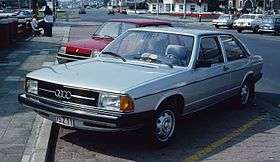 Audi 100 2-door sedan | |
| Overview | |
| Also called | Audi 5E (Australia)[15] |
| Production | 1976–1982 988,581 100 4-door: 887,647[16] Avant: 49,652 200: 51,282 |
| Assembly |
|
| Body and chassis | |
| Body style | 2-door saloon/sedan 4-door saloon/sedan 5-door hatchback |
| Layout | Front engine, front-wheel drive |
| Platform | Volkswagen Group C2 platform |
| Powertrain | |
| Engine |
|
| Transmission | 3-speed automatic 5-speed manual |
| Dimensions | |
| Wheelbase | 105.4 in (2,677 mm)[17] |
| Length | 184.3 in (4,681 mm)[17] |
| Width | 69.6 in (1,768 mm)[17] |
| Height | 54.8 in (1,392 mm)[17] |
| Curb weight | 2,532 lb (1,148 kg)[17] |
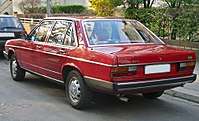
The restyled C2 Audi 100 was launched in 1976, with an in-line five-cylinder engine. It was initially a 100 PS (74 kW) engine offering "six-cylinder power and four-cylinder economy", and later upgraded to 136 PS (100 kW).
The Coupé was discontinued, but a five-door hatchback model, the 100 Avant, was launched in August 1977 as part of this generation. The mainstay of the range remained the four-door sedan model. A two-door sedan version was offered, primarily on the domestic market, from February 1977, but by now there was little demand for large two-door sedans and thus only a few of these two-door Audi 100 C2s were sold.[18] At the top of the line, the Audi 200 made its appearance at the 1979 Frankfurt Show, with fuel injected five-cylinder engines in either naturally aspirated or turbocharged forms.[19]
At the end of September 1977, the Audi 100 became the manufacturer's first model to reach a production level of 1,000,000 units.[20] The millionth Audi 100 was a hatchback Audi 100 Avant assembled not at the company's main Ingolstadt plant but to the west, at the Neckarsulm factory which, since the demise of the mainstream volume models from the NSU range, had been concentrating on providing additional production capacity for the fast selling Audi range.[20] The 100 C2 effectively became a de facto successor to the similarly sized NSU Ro80 which ceased production in 1977, and the NSU name gradually disappeared from the public consciousness - eventually being erased from the company name completely in 1985 when Audi NSU Auto Union AG renamed itself Audi AG.
Engines available outside of North America included:
- 1.6 L I4, 85 PS (63 kW; 84 hp), carburetted (1976−1982)
- 2.0 L I4, 115 PS (85 kW; 113 hp), carburetted (1976−1978)
- 1.9 L I5, 100 PS (74 kW; 99 hp), carburetted (1980−1982)
- 2.1 L I5, 115 PS (85 kW; 113 hp), carburetted (1978−1982)
- 2.1 L I5, 136 PS (100 kW; 134 hp), fuel injection (1976−1982) (100 and 200)
- 2.1 L I5, 170 PS (125 kW; 168 hp), fuel injection, turbo (1979−1982) (200 only)
- 2.0 L I5 Diesel, 70 PS (51 kW; 69 hp), (1978−1982)
About 850,000 Audi 100/200 C2s were built,[21] of which 133,512 were sold in the United States.[22]
The RHD Audi 200 5E and 5T were introduced into the UK in 1979, only 500 were imported. The 5T (170 PS) was a higher spec Turbo version of the 5E (136 PS injection) and came with many optional extras as standard. The UK version of the 5T had opening quarter lights, electric door mirrors, a sunroof, cruise control and heated seats. All Type 43 200's came with automatic gearboxes, with a five-speed manual available by special order.
The C2 was sold as the Audi 5E in Australia. It was part of a very restricted Audi lineup, being the only model on offer for several years.[23] The only engine on offer was the fuel injected (Bosch K-jetronic) 2144-cc inline-five with 85 kW (114 hp), coupled to a four-speed manual or 3 speed automatic in the GL and the 100kw Version with rare 5 speed manual or a three-speed automatic in the CD.[23]
Audi 5000 (1978-1983)
In North America, where 133,512 of the Audi 5000 C2s were sold, only five-cylinder engines were available. The 5000 had twin round headlamps for the first two model years, after which they were replaced by rectangular units. The diesel was originally not available in California, as Porsche-Audi of North America was unable to meet that state's strict emissions standards.[24] The naturally aspirated diesel was also only available with a five-speed manual, a handicap in the American market. It was not until the 1983 introduction of the turbodiesel that these concerns were met. The 50-state Turbodiesel arrived for the 1983 model year, at about the same time that the Audi 100 C3 was presented in Europe, and was only ever sold in the United States.[25]
In 1980 the 5000 Turbo arrived in the US. This model only delivered 130 hp (97 kW), more than twenty percent less than the European spec model. Aside from meeting the strict US emissions, this model also had lower boost pressure to be able to run on the lower octane unleaded fuel available in America.[26] While the Turbo also received a harder, sportier suspension, bigger aluminium wheels, and other performance upgrades, it was also only available with a three-speed automatic transmission.[27] Road & Track were able to reach a top speed of 113 mph (182 km/h) in the federalized car, slower than a naturally aspirated European market 2.1 E.[28] In the US, reflecting the Audi's luxury connotations, 90 percent of 5000s received the costlier "S" equipment package.[29]
The 5000 Turbodiesel received a useful increase in power and torque, offset somewhat by only being available in conjunction with Audi's "3+E" automatic transmission. This was a three-speed automatic in which the "E" mode engaged a freewheel effect, lowering fuel consumption by 3-5 percent.[30] The Turbodiesel received the same body and interior specifications as the gasoline-powered turbo; the only difference was the use of 14-inch alloy wheels rather than the wider 15-inch items mounted on the 5000 Turbo.[25]
North America:
- 2.1 L I5, 103 hp (77 kW; 104 PS), fuel injection (MY 1978−1983). 100 hp (75 kW) from 1980 on.
- 2.1 L I5, 130 hp (97 kW; 132 PS), fuel injection, turbo (MY 1980−1983)
- 2.0 L I5 diesel, 67 hp (50 kW; 68 PS)[24] (MY 1980−1982)
- 2.0 L I5 turbodiesel, 84 hp (63 kW; 85 PS) (MY 1983)
Audi 100, 200 and 5000 (C3, 1982–1991)
| Audi 100, 200 and 5000 C3 (44) | |
|---|---|
_(10629216834).jpg) 1982–1988 Audi 100 sedan | |
| Overview | |
| Also called | Hongqi Mingshi Hongqi CA5020 XJH (station wagon) CA7180A2E/CA7200/CA7202/CA7220/CA7246L |
| Production | 1982–1991 (Germany) 1988–1999[31][32](China; FAW-VW - Audi 100 and 200) 1988–2005[33][34][35][36][37] (China; Hongqi - Hongqi CA7180A2E/CA7200 and CA7220/Limousine variants/CA1021U3 pickup truck) |
| Model years | 1989–2005 (China) |
| Assembly |
|
| Body and chassis | |
| Body style | 4-door saloon/sedan 5-door estate/wagon |
| Layout | Front engine, front-wheel drive / quattro permanent four-wheel drive[38] |
| Platform | Volkswagen Group C3 platform |
| Powertrain | |
| Engine |
|
| Transmission | 4/5-speed manual 3/4-speed automatic |
| Dimensions | |
| Wheelbase | 105.6 in (2,682 mm) (1988–1991 FWD & 200) 105.9 in (2,690 mm) (1988–1990 AWD & Wagons) 105.8 in (2,687 mm) (Pre-1988) |
| Length | 188.7 in (4,793 mm) (global) 192.7 in (4,895 mm) (USA) |
| Width | 71.4 in (1,814 mm) |
| Height | 55.9 in (1,420 mm) 55.7 in (1,415 mm) (S) |
| Chronology | |
| Successor | China: Audi A6 (for Audi 100 and 200) Toyota Crown Majesta (for Hongqi models) |
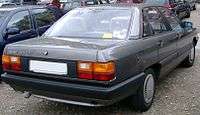
.jpg)
The third generation Audi 100, launched in September 1982, had an aerodynamic look, achieving a drag coefficient of 0.30 for its smoothest base model. The increased aerodynamic efficiency resulted in better fuel economy. The design was in contrast from the boxy shape of the C2. Audi innovated flush windows on the C3, a key area for aerodynamic drag that has been widely adopted by other manufacturers. The aerodynamic body gave the 100 higher top speed than other cars of similar engine size.[39] A new technology introduced in the C3 included the procon-ten safety system.
The two-door models were no longer available, and the Audi 100 Avant was now positioned as a station wagon rather than a hatchback - the Avant designation would now be used for all Audi station wagons from that point forward. The Avant was introduced with available extra folding third row seat — not available in conjunction with ABS-brakes as the brake control unit sat in the same space.[40] The 200, launched in 1983 continued as the upmarket variant with several versions of the 2.2 L turbo 5-cylinder available in different markets over its life ranging in power outputs from 165 PS (121 kW) MC engine, through the 200 PS (147 kW) versions to the final 220 PS (162 kW) 20-valve 3B engine available from 1991. The 1983 Audi 200 Turbo had a top speed of 139 mph (224 km/h).[41] The MC turbo engine was available in the 100 as well for some markets.
In January 1988 the Audi 100 received a subtle facelift, most obvious being the change to flush fitting doorhandles. The 1991 200 20V featured flared (vs. flat) front and rounded rear wheel arches to accommodate wider wheel and tire combinations to be fitted to 20V models. U.S. magazine articles of the period reported 0-60 times of the 20-valve Audi 200 under 7 seconds, with 1/4 mile times in the mid to upper 15 second mark.[42]
The Audi 100 also featured a 2.5 L straight-five direct injection turbo-diesel (TDI) model with 120 PS (88 kW) introduced in January 1990 (engine code 1T). This was the first model to wear the TDI label. It had a brief career in the C3, being replaced in December of that year when the C4 arrived.
Reported sudden unintended acceleration
During model years 1983–1987, Audi's U.S. sales fell after a series of recalls of Audi 5000 models[43] associated with reported incidents of sudden unintended acceleration linked to six deaths and 700 accidents.[43] At the time, National Highway Traffic Safety Administration (NHTSA) was investigating 50 car models from 20 manufacturers for sudden surges of power.[44]
In North America, the CBS television broadcast network 60 Minutes news program aired a report titled Out of Control on November 23, 1986.[45] It featured interviews with six people who had sued Audi after reporting unintended acceleration, including footage of an Audi 5000 ostensibly displaying a surge of acceleration while the brake pedal was depressed.[46][47][48] Subsequent investigation revealed that 60 Minutes had not disclosed they had engineered the vehicle's behavior – fitting a canister of compressed air on the passenger-side floor, to pump fluid via a hose to a hole drilled into the transmission[45][46] — the arrangement executed by one of the experts who had testified on behalf of a plaintiff in a then-pending lawsuit against Audi's parent company.[49]
Audi initially responded by suggesting that the drivers of the cars involved in the incidents were at fault, because they had stepped on the accelerator pedal rather than the brake.[44] Subsequently, the National Highway Traffic Safety Administration (NHTSA) concluded that the majority of unintended acceleration cases, including all the ones that prompted the 60 Minutes report, were caused mainly by factors such as confusion of pedals.[50] CBS acknowledged the report and stressed its findings that “the problem could be aggravated by vehicle design, the shape, location and feel of gas and brake pedals."[49] Audi's research demonstrated that many of the drivers who encountered "unintended acceleration" were "below average in height", indicating their knowledge of a relationship between design and the incidents.[51]
In a review study published in 2012, NHTSA summarized its past findings about the Audi unintended acceleration problems: "Once an unintended acceleration had begun, in the Audi 5000, due to a failure in the idle-stabilizer system (producing an initial acceleration of 0.3g), pedal misapplication resulting from panic, confusion, or unfamiliarity with the Audi 5000 contributed to the severity of the incident."[52]
This summary is consistent with the conclusions of NHTSA's most technical analysis at the time: "Audi idle-stabilization systems were prone to defects which resulted in excessive idle speeds and brief unanticipated accelerations of up to 0.3g [which is similar in magnitude to an emergency stop in a subway car]. These accelerations could not be the sole cause of [(long-duration) sudden acceleration incidents (SAI)], but might have triggered some SAIs by startling the driver.[53] The defective idle-stabilization system performed a type of electronic throttle control. Significantly: multiple "intermittent malfunctions of the electronic control unit were observed and recorded … and [were also observed and] reported by Transport Canada."[53]
With the series of recall campaigns, Audi made several modifications; the first adjusted the distance between the brake and accelerator pedal on automatic-transmission models.[43] Later repairs of 250,000 cars dating back to 1978 added a device requiring the driver to press the brake pedal before shifting out of park.[43] It is unclear what was done regarding the defects in the idle-stabilization system. Subsequent to the recall campaigns, vehicles now include gear shift patterns and brake interlock mechanisms to prevent deliberate gear selection.
Audi's U.S. sales, which had reached 74,061 in 1985, dropped to 12,283 in 1991 and remained level for three years.[43] – with resale values falling dramatically.[54] Audi subsequently offered increased warranty protection[54] and renamed the affected models — with the 5000 becoming the 100 and 200 in 1989.[44] The company only reached the same level of U.S. sales again by model year 2000.[43]
As of early 2010, a class-action lawsuit — dealing with a charge that on account of the sudden acceleration controversy, Audi models had lost resale value[46] — filed in 1987 by about 7,500 Audi 5000-model owners remains unsettled and is currently contested in county court in Chicago after appeals at the Illinois state and U.S. federal levels.[55] The NHTSA's findings have been "small solace for Audi in defense of product liability actions, as more and more successful cases used Audi's human factor design errors and failure to warn or recall as a basis for liability."[56]
Engines
The engine range comprised the following engines:[57][58] More details under the discontinued VAG engines.
Audi 100:
- 1.8 L I-4, 75 PS (55 kW; 74 hp), carburetted (1982−1987)
- 1.8 L I-4, 90 PS (66 kW; 89 hp), carburetted, later fuel injected/with catalyst (1983−1990)
- 1.9 L I-5, 100 PS (74 kW; 99 hp), carburetted (1982−1984)
- 2.0 L I-5, 115 PS (85 kW; 113 hp), fuel injection, later catalyst (1984−1990)
- 2.1 L I-5, 136 PS (100 kW; 134 hp), fuel injection (1982−1984)
- 2.2 L I-5, 138 PS (101 kW; 136 hp), fuel injection (1984−1990)
- 2.2 L I-5, 115 PS (85 kW; 113 hp), fuel injection, catalyst (1984−1987)
- 2.3 L I-5, 136 PS (100 kW; 134 hp), fuel injection, catalyst (1986−1990)
- 2.2 L I-5, 165 PS (121 kW; 163 hp), fuel injection, turbo, catalyst (1986−1990)
- 2.0 L I-5 Diesel, 70 PS (51 kW; 69 hp) (1982−1989)
- 2.0 L I-5 Turbodiesel, 87 PS (64 kW; 86 hp) (1983−1988)
- 2.0 L I-5 Turbodiesel, 100 PS (74 kW; 99 hp) (1988−1989)
- 2.4 L I-5 Diesel, 82 PS (60 kW; 81 hp) (1989−1990)
- 2.5 L I-5 TDI, 120 PS (88 kW; 118 hp) (1990)
Audi 200:
- 2.1 L I-5, 136 PS (100 kW; 134 hp), fuel injection (1983−1984)
- 2.2 L I-5, 138 PS (101 kW; 136 hp), fuel injection (1984−1985)
- 2.2 L I-5, 165 PS (121 kW; 163 hp), fuel injection, turbo, catalyst (1985−1991)
- 2.1 L I-5, 182 PS (134 kW; 180 hp), fuel injection, turbo (1983−1987)
- 2.2 L I-5, 200 PS (147 kW; 197 hp), fuel injection, turbo (1988−1990); 190 PS (140 kW; 190 hp) with automatic transmission
- 2.2 L I-5, 220 PS (162 kW; 217 hp), 20-valve turbo for 200 Quattro 20V (1989−1991)
Audi 5000/100/200 North America (all fuel injected and catalysed):
- 2.1 L I-5, 100 hp (75 kW; 101 PS) (MY 1984)
- 2.2 L I-5, 115 hp (86 kW; 117 PS) (MY 1985)
- 2.2 L I-5, 110 hp (82 kW; 112 PS) (MY 1986−1987½)[59]
- 2.3 L I-5, 130 hp (97 kW; 132 PS) (MY 1987½−1991)
- 2.1 L I-5 Turbo, 140 hp (104 kW; 142 PS) (MY 1984−1985)
- 2.2 L I-5 Turbo, 158 hp (118 kW; 160 PS) (MY 1986−1987½)[59]
- 2.2 L I-5 Turbo, 162 hp (121 kW; 164 PS) (MY 1987½−1991)
- 2.2 L I-5 20-valve Turbo, 217 hp (162 kW; 220 PS) (MY 1991)
The 5000 S/Turbo was on Car and Driver's Ten Best list for 1984 and 1985. The CS Turbo quattro was on that list for 1986 through 1988.
| Production Figures[60] | |
| 100 | 852,243 |
| 100 Avant | 122,852 |
| 200 | 97,195 |
| 200 Avant | 6,153 |
| Total | 1,078,443 |
Motorsport
In 1988, Audi entered the Trans-Am Series with the 200 turbo quattro by contracting Bob Tullius Group 44 Racing. The car was equipped with the Quattro system. The car was piloted by Hurley Haywood and with both Walter Röhrl and Hans-Joachim Stuck won eight out of thirteen events. Audi moved to IMSA by the end of the season, the SCCA would change the regulation to a two-wheel drive only and banning cars with non-American engines. The Historic Trans-am & IMSA Group[61] is dedicated to the preservation of the cars that ran in the SCCA Trans-am series and the similar IMSA GTO class from 1980 until 1991.
Audi also used the 200 Turbo Quattro 20v as their Group A rally car replacement for the aging Audi Quattro after the FIA elimination of Group B in 1986. The 1987 Group A 200 was driven by former World Rally Champions drivers drivers Hannu Mikkola and Walter Röhrl. The Audi 200 became the first four-wheel-drive car to win the Safari Rally, with Hannu Mikkola driving. The 200 Quattro became the last car Audi campaigned in rallying as a manufacturing team.
Gallery
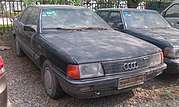 FAW-manufactured Audi 100
FAW-manufactured Audi 100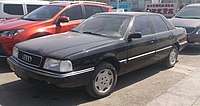 FAW Audi 200
FAW Audi 200 1990 facelift (Avant TDI)
1990 facelift (Avant TDI)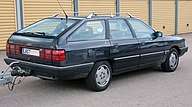 1990 facelift
1990 facelift
Audi 100 (C4, 1990–1994)
| Audi 100 C4 (4A) | |
|---|---|
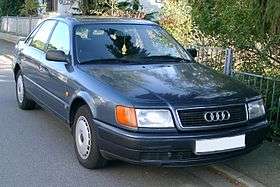 | |
| Overview | |
| Production | 1990–1994 |
| Assembly | Germany: Neckarsulm |
| Designer | Erwin Leo Himmel (1987) |
| Body and chassis | |
| Body style | 4-door saloon/sedan 5-door estate/wagon |
| Layout | Front engine, front-wheel drive / quattro permanent four-wheel drive |
| Platform | Volkswagen Group C4 platform |
| Powertrain | |
| Engine | Petrol: 2.0 L I4 74 kW (99 hp) SPI 2.0 L I4 85 kW (114 hp) MPI 2.0 L I4 103 kW (138 hp) 16-valve 2.2 L I5 169 kW (227 hp) T (S4) 2.3 L I5 98 kW (131 hp) 2.6 L V6 110 kW (148 hp) 2.8 L V6 128 kW (172 hp) 4.2 L V8 206 kW (276 hp) (S4) Diesel: 2.4 L I5 60 kW (80 hp) 2.5 L I5 85 kW (114 hp) TDI |
| Transmission | 4-speed automatic 5-speed manual 6-speed manual |
| Dimensions | |
| Wheelbase | 105.8 in (2,687 mm) (FWD) 106 in (2,692 mm) (4WD) |
| Length | 192.6 in (4,892 mm) |
| Width | 70 in (1,778 mm) |
| Height | 56.3 in (1,430 mm) 56.6 in (1,438 mm) (FWD saloon) 57 in (1,448 mm) (FWD Avant) |

Audi released the C4 (a heavily revised C3) in late 1990 in Continental Europe and 1991 in other markets, including the right-hand drive British market.[62] The C3-platform Audi V8 continued to be sold as a separate line. The major change for the C4 was the introduction of a 2.8 L, 90-degree, SOHC 12v, V6 engine. It was later joined by a 2.6 L variant, of the same configuration as the 2.8 L unit. They are essentially the same engines offered in the 1992, B4 Audi 80. The option of quattro permanent four-wheel drive was an option across the range, and the Audi 100 quattro was available with a ZF four-speed automatic gearbox.
This generation was also available with a 2.5 litre, 5-cylinder TDi engine, which provided outstanding performance, economy and refinement.
For the 1995 model year, in conjunction with some styling revisions, Audi dropped the Audi 100 tag, renaming it the A6 instead. In addition, the existing 100-derived Audi S4 became the S6. The S4 name was later re-used for the high-performance derivative of the Audi A4 (replacement for the Audi 80). The Audi V8 had been replaced by the A8 in 1994.
The C4-based A6 continued until early 1997, when it was replaced by an all-new A6.
Type numbers
In addition to the C platform codes, Audi assigned type numbers to their models:
- F104: C1; Audi 100 (1968–1976)
- Type 43: C2; Audi 100 (1976–1982); Audi 200 (1979–1982)
- Type 44: C3; Audi 100 (1983–1991); Audi 200 (1983–1992)
- Type 4A: C4; Audi 100 (1990–1994); Audi S4 (1992–1994); Audi A6 (1994–1997); Audi S6 (1994–1997)
Chinese production

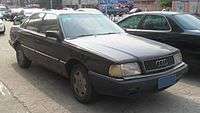
Audi 200 (bottom)
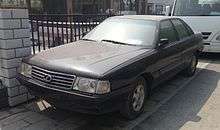

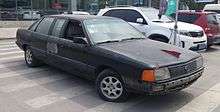
The C3-platform Audi 100 was also produced in Changchun, China, by FAW (First Automobile Works, a Chinese automotive manufacturer) starting in 1988. Since most products in China are designed for government use, all 100s manufactured as FAWs were front-wheel drive sedans with a 2.0 L inline-4 motor or a 2.2 L inline-5 motor.
In 1990, Politburo of the CCP approved a resolution to circumscribe car import and the engine displacement of cars equipped to officials. Furthermore, the resolution also prescribed that all cars of central departments of both Party and government must be domestic built. As the most luxurious and advanced cars made in China in early-1990s, FAW-Audi 100 and 200 had a high percentage of the Chinese high-class market of executive cars for nearly one decade, until the C3-platform cars was replaced by C4 based Audi A6 in 1999.
During the negotiation between FAW and Volkswagen in late-1980s, Volkswagen acceded to FAW's suggestion of combining the C3 platform with previously introduced Chrysler engines in the new generation Hongqi (Red Flag). Hongqi CA7200 series with the technology of C3 were launched in mid-1990s, while most of C3 Audi 100 parts could be made in China. CA7200 were initially equipped with a 2.0 L or 2.2 L Chrysler 4-cylinder engine, whose product line was introduced into China in 1987. In 2000s (decade), new Nissan VQ20 engines replaced the original 4-cylinder petrol engine.[63]
A small number of C3 200s (with 1.8T or 2.6 V6 engine) and some early C4 100s (largely in European style but with tail lights in American style) were also assembled in Changchun. The 1.8 litre Hongqi engine was known as the QG18 while the 1.8 turbo was Volkswagen's EA827 engine. All Chinese spec Audi 100s and Hongqis were front wheel drive and had a 5 speed manual gearbox as standard
Hongqi production commenced in 1993 and ended in 2005 where the Toyota Crown Majesta S180 replaced it as its successor under the name HQ3 and HQ430.
Audi Duo
At the Geneva Motor Show in March 1990[64] Audi presented its first iteration of the Audi Duo (or Audi 100 Avant Duo) experimental vehicle, a plug-in parallel hybrid based on the Audi 100 Avant quattro. This car had a 12.6 bhp (9.4 kW) Siemens electric motor which drove the rear wheels. A trunk-mounted nickel-cadmium battery supplied energy to the motor that drove the rear wheels. The vehicle's front wheels were powered by a 2.3-litre five-cylinder engine with an output of 136 PS (100 kW; 134 hp). The intent was to produce a vehicle which could operate on the engine in the country and electric mode in the city. Mode of operation could be selected by the driver. Ten vehicles are believed to have been made; one drawback was the extra weight of the electric drive, making vehicles less efficient when running on their engines alone than standard Audi 100s with the same engine.
In late 1991,[65] Audi unveiled the second Duo generation – likewise based on the Audi 100 Avant quattro. Once again this featured an electric motor, a 28.6 PS (21 kW; 28 hp) three-phase machine, driving the rear wheels. This time, however, the rear wheels were additionally powered via the Torsen differential from the main engine compartment, which housed a 2.0-litre four-cylinder engine.
References
- The Horch brand was part of the Auto Union, which was in the mid-60s renamed to Audi. The previous car of the same type and class, manufactured by the concern before the release of the Audi 100, was the Horch P240.
- Werner, Oswald. Deutsche Autos 1945–1990. 4. p. 268. ISBN 3-613-02131-5.
- "Autotest Audi 100 Coupe S". Autocar. 136 (3960): 22–27. 9 March 1972.
- Oswald, Werner (2001). Deutsche Autos 1945-1990 [German Cars 1945-1990] (in German). 4. Motorbuch Verlag. p. 268. ISBN 3-613-02131-5.
Das die Motoren des Audi 100 ziemlich rauh liefen, vermochte deutsche Käufer, die ja grossenteils vom VW-Käfer kamen und zum Mercedes-Diesel strebten, kaum zu stören.
- Turner, Philip (24 July 1971). "Turner's Travel [to Wolfsburg]". Motor: 28–30.
- Braunschweig, Robert; et al., eds. (11 March 1971). "Automobil Revue '71" (in German and French). 66. Berne, but in Switzerland: Hallwag SA: 196. Cite journal requires
|journal=(help) - Automobil Revue '71, pp. 140, 148
- "News and Views". Autocar. 134 (3914): 31. 1 April 1971.
- Howard, Tony (December 1976). "New VWs reflect determinedly cheerful mood". SA Motor. Cape Town, South Africa: Scott Publications: 33.
- Renaux, Jean-Jacques (23 February 1984). "Volkswagen soulève un coin du voile: Wunderbar!" [VW raises the veil: Wunderbar!]. Le Moniteur de l'Automobile (in French). Brussels, Belgium. 35 (789): 9.
- Flammang, James M. (1994). Standard Catalog of Imported Cars, 1946-1990. Krause Publications. p. 62. ISBN 0-87341-158-7.
- Flammang, p. 63
- Flammang, p. 64
- Flammang, p. 66
- Audi 5E advertisement, Volkswagen Australia Pty Limited, Australian Playboy, April 1979, page 179
- Oswald, op. cit., p. 263. Figures given for calendar years; some overlap with predecessor/successor, actual figures slightly lower.
- "Autotest Audi 100 GLS". Autocar. 146 (4197): 26–30. 16 April 1977.
- Oswald, Werner (2001). Deutsche Autos 1945-1990 (in German). 4. Motorbuch Verlag. p. 313. ISBN 3-613-02131-5.
- Rombauts, Walter, ed. (1979-09-15). "Mercedes en Audi overbluffen iedereen op Salon van Frankfurt" [Mercedes and Audi outdo everyone at the Frankfurt Salon]. Keesings Auto Magazine (in Dutch). Antwerp, Belgium. 2 (18): 14.
- "Jubiläum bei Ausi in Neckarsulm". Auto, Motor und Sport. 21: 7. 12 October 1977.
- Werner Oswald: Deutsche Autos 1945–1990, vol. 4, ISBN 3-613-02131-5, p. 263
- Mike Covello, Standard Catalog of Imported Cars 1946–2002. Krause Publications, Iola 2002, ISBN 0-87341-605-8, p. 82–85.
- Boyce, David, ed. (1981), What car is that? in Australia & New Zealand, Adelaide, Australia: Rigby, pp. 190–191, ISBN 0727014803
- Hogg, Tony (ed.). "Four mid-size diesel sedans". Road & Track's Road Test Annual & Buyer's Guide 1981 (January–February 1981): 28.
- Nagy, Bob (September 1982). "For our eyes only". Motor Trend. Vol. 34 no. 9. Petersen Publishing. p. 51.
- Hogg, Tony. "Editor's year: A time of change". Road & Track's Road Test Annual & Buyer's Guide 1981 (January–February 1981): 4.
- Hogg, Tony (ed.). "Audi 5000 Turbo: An excellent automobile made spectacular". Road & Track's Road Test Annual & Buyer's Guide 1981 (January–February 1981): 39–40.
- Audi 5000 Turbo, p. 41
- Hogg, Tony (ed.). "1981 Buyer's Guide". Road & Track's Road Test Annual & Buyer's Guide 1981 (January–February 1981): 82.
- Nagy, p. 52
- "Spotted in China: Audi 100".
- "Spotted in China: Audi 200".
- "Spotted in China: Hongqi CA7180A2E".
- "Spotted in China: Hongqi CA7200".
- "All The Hongqi Stretched Limousine Variants Based On The Audi 100/200".
- "Spotted in China: Hongqi CA1021U3".
- "Spotted in China: Spotted In China: Hongqi Yunhe CA5020 XBYA Stretched Wagon Hearse".
- Audi of America Press Site 25 Years of Audi Quattro Archived 2008-06-19 at the Wayback Machine 22 February 2005
- CAR Magazine Sept 1982
- Söderlind, Alrik (1987-03-04). "Maratonlöparen" [The marathon runner]. Teknikens Värld (in Swedish). Stockholm, Sweden: Specialtidningsförlaget AB. 39 (6): 66.
- Autocar 27/4/85
- "SJM Autotechnik Troubleshooting / Performance". SJM Autotechnik (Sourced by Car & Driver + Road & Track).
- Cremer, Andreas; Lavell, Tom (4 February 2010). "Audi 1980s Scare May Mean Lost Generation for Toyota". Business Week. Archived from the original on 2010-02-08.
- Holusha, John (24 July 1988). "A Hard Sell for Audi". The New York Times. Retrieved 15 June 2015.
- Niedermeyer, Paul (7 March 2010). "The Audi 5000 Intended Unintended Acceleration Debacle". The Truth About Cars. Retrieved 15 June 2015.
- Huber, Peter W. (18 December 1989). "Manufacturing the Audi Scare". The Wall Street Journal.
- Civil Justice Memo, No. 18 January 1990 Manufacturing the Audi Scare
- Accuracy in Media The CBS “Cold Case” Files
- "Media Myth: Nine Worst Business Stories (of the Last 50 Years)". businessandmedia.org. Archived from the original on 5 October 2009. Retrieved 15 June 2015.
- HighBeam Research, Inc. Unfair at Any Speed
- Terris, Daniel (9 November 1986). "How safe is the Audi 5000?". The Boston Globe. p. 17.
- "Pedal Application Errors" (PDF). March 2012. Retrieved 3 December 2013.
- "Study of Mechanical and Driver-Related Systems of the Audi 5000 Capable of Producing Uncontrolled Sudden Acceleration Incidents" (PDF). September 1988. Retrieved 3 December 2013.
- "Audi Increases Warranty Plan". The New York Times. Reuters. 27 July 1988. Retrieved 15 June 2015.
- Cremer, Andreas; Lavell, Tom (4 February 2010). "Audi 1980s Scare May Mean Lost Generation for Toyota Sales". Bloomberg. Retrieved 15 June 2015.
- "Audi Sudden Acceleration". The Center for Auto Safety. Retrieved 15 June 2015.
- Oswald, op. cit., p. 319–329.
- Covello, op. cit., p. 85–89.
- Audi: Advancing the art of engineering (Brochure), Volkswagen Canada Inc, December 1985, p. 13, 12-99-10112
- Oswald, op. cit., p. 263. Note: figures given for calendar years, might include late C2 production; figures for 200 not including 1991.
- "Historic Trans-Am Imsa". Historic Trans-Am Imsa. 1986-06-09. Retrieved 2009-05-11.
- "Audi 100 (C4) Prospekt Dezember 1990 NEU". Automobil-literatur.de. Retrieved 15 June 2015.
- "The FAW is over for Red Flag". Chinese Car News. 23 November 2006. Archived from the original on 16 February 2007. Retrieved 27 February 2015.
- Eberhard Kittler: Deutsche Autos seit 1990, Bd. 5 ("German Cars since 1990, vol. 5"). Motorbuch Verlag, Stuttgart 2001, ISBN 3-613-02052-1, p.65
- Eberhard Kittler: Deutsche Autos seit 1990, Bd. 5 ("German Cars since 1990, vol. 5"). Motorbuch Verlag, Stuttgart 2001, ISBN 3-613-02052-1, p.71
Sources
- Covello, Mike, updated by, Standard Catalog of Imported Cars: 1946–2002, Krause Publications, Iola, Wisconsin, U.S.A., 2002.
- Werner Oswald: Deutsche Autos 1945–1990, vol. 4. Motorbuch Verlag, Stuttgart 2001, ISBN 3-613-02131-5 (German).
External links

- Audi recalls since 1977
- Audi 100 models USA 1990-1994
.jpg)
_ret.jpg)